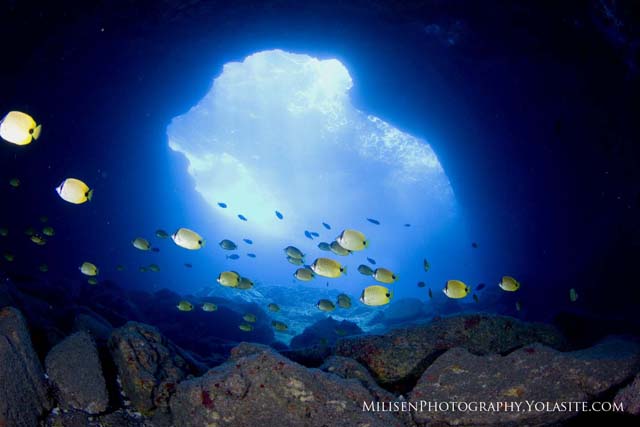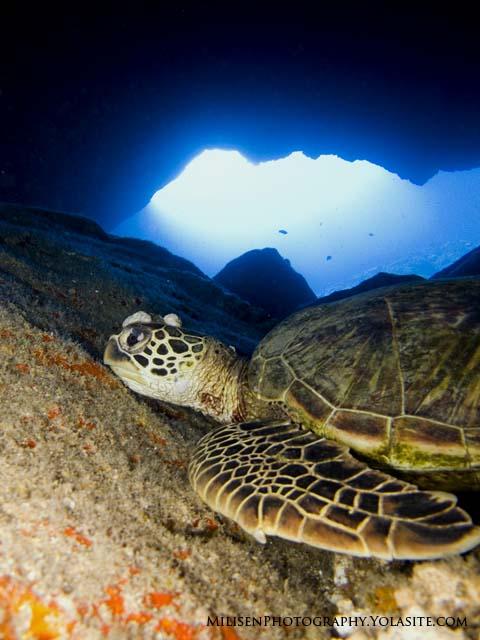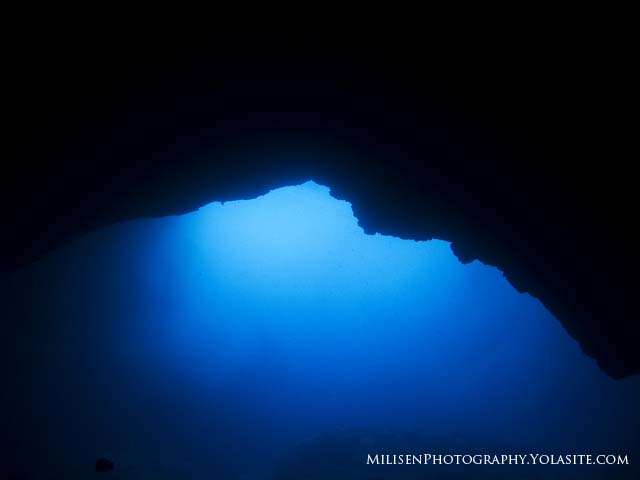
After a while of diving the same spots over and over again, Oahu shoredivers often start branching out by exploring various drifts. Drifting enables a diver to explore new territory throughout the dive by negating the need to double back to get to the exit. There are two real downsides to this. First, these can be quite advanced and require lots of planning. Also, because you have a distance to go (start to finish) and limited time to get there (how much air is in your tank), you don’t really get to slow down and check out the small stuff. For example, one of my first drifts was on the north shore swimming from Three Tables to Shark’s Cove. In the right conditions, this is a relatively benign “drift-dive." There are a few other, much more advanced dives but half the fun of drift diving from shore is finding an appropriate entry and exit. I wouldn’t want to spoil that for you. I do want to warn you against attempting to swim from Hanauma Bay to Portlock.
My buddy, Andrew, and I got it into our heads that this would be fairly straightforward. We knew the currents coming out of Portlock were entirely tide driven and thought the same rule applied to Hanauma Bay’s Pai Olu Olu point, aka Sneezing Baboon. An incoming tide would provide fresh, clean water to swim in and a free, current driven ride to our exit at Portlock. At first glance, the swimming distance of .75 miles didn’t seem much further than other drifts we had navigated with success. We waited until we had a morning of a seriously high rising tide, strapped on our doubles and went for it. We slogged through the half-mile surface swim out to the point and dropped, but there was an immediate problem. The current at the mouth of the bay was going the wrong way! We had no idea how far we would have to negotiate this counter-current before reaching the inflush at Portlock, so, we signaled confusedly at each other and turned around. The morning that was meant to be an exploration of unbroken ground quickly turned into just another day at the bay. Later that evening while checking where we went wrong, I again measured the distance between our drop-point and Portlock’s exit, but this time it came out to be closer to 1.5 miles. Add to that the half-mile surface-kick out to the point and we were looking at a two-mile swim with full scuba gear!
We never gave up on the drift, we just needed to approach it in a different way, so we bought a boat and immediately named it after the first person to get seasick and vomit from it. As far as boats go, the Stacey Anne is more accurately called a dinghy. At a microscopic fifteen feet in length, it fits four snug divers and shuttles them at a miserable 8 mph, or roughly the speed of smell. Anything more than 15 mph winds and we turn around, which in Hawaii happens pretty frequently. So to complete this dive we had to wait for a window of decent weather and a strong incoming tide.
With six tanks and only three of us on board, we staggered buddy pairs such that as two were exploring, the third diver would drive the boat following bubbles and surface markers. The first buddy pair, myself included, drifted along a beautiful slope of unmolested coral the likes of which can only be compared favorably to Kona. Clouds of fish rained on us from everywhere. Already our planning had proven fruitful. We stopped at the entrance to what we would later learn is a site called “Sea Cave.” We barely had enough time to poke our heads in lest we ran out of air. What we glimpsed, however, can only be described as a natural cathedral. The cavern was enormous, roughly twice the size of the inside bases of a baseball diamond. A large chunk of the ceiling collapsed, providing a “light of God” feel to the place. The scene was punctuated by an abundance of diverse life ranging from scores of butterflyfish to turtles and even a whitetip reef shark. Mollusks packed every crevice. The reef outside was staggering, but the unique feel of this cave makes this site one of Oahu’s best.
The rest of the dives were much like the first with declining diversity as one drifted toward Portlock. It eventually took us a full three and a half dives to drift from the point, explore Sea Cave, and finally climb out at Portlock. I’m glad we met with a counter-current on our first attempt. Our bad planning would have meant a little bottom time followed by a long day of kicking on the surface, all while completely missing the gorgeous reefs and mysterious caves that lay just 60 feet below.

A Hawaiian green sea turtle (Chelonia mydas) rests in the foyer at Sa Cave.

The modest entrance of Sea Cave.
